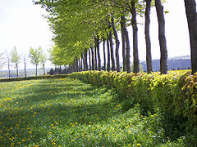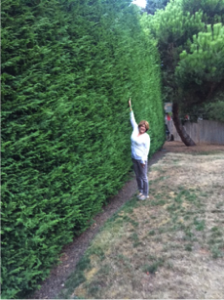More Notable Walls
1600s: Wall Street, New York
Wall Street in New York City is only 0.7 mile long but is the financial center of the United States and perhaps the world. One theory of the Dutch-named "de Waal Straat" is that a wall was constructed to protect the Dutch colony from the British or Native American tribes. Another theory has it that in the 1640s both African slaves and white colonists collaborated with the city government in the construction of a more substantial fortification, a strengthened 12-foot (4 m) wall. In some sense the United States started with a wall and in some ways average people are still walled off from Wall Street. (Wikipedia)
Black Wall Street (Greenwood, Tulsa Oklahoma)
Greenwood is a neighborhood in Tulsa, Oklahoma. As one of the most successful and wealthiest black communities in the United States during the early 20th century, it was popularly known as America's "Black Wall Street" until the acts of terror by white residents lead to the Tulsa race riot of 1921, in which white residents massacred black residents and razed the neighborhood within hours. The riot was one of the most devastating terrorist attacks by whites in the history of U.S. race relations, destroying the once thriving Greenwood community.
Black Wall Street - Wikipedia - https://en.wikipedia.org/wiki/Greenwood,_Tulsa
The Destruction of Black Wall Street, in Ebony, BY JOSIE PICKENS, MAY 31, 2013 - http://www.ebony.com/black-history/the-destruction-of-black-wall-street-405#axzz3wJ8lqHYY
Australia: Rabbit-proof Fence
Rabbits in Australia were a very costly invasive species. From 1901 until 1907 the rabbit-proof fence or a pest-exclusion fence was built across Western Australia to control the spread of the rabbit population from Eastern Australia. There were ultimately 3 fences, totaling approximately 2,000 miles and costing almost $1 million dollars at that time. Upon its completion in 1907 the number 1 fence of about 1,100 miles was the longest unbroken fence in the world. It naturally did not work as the European rabbit both jumps very high and burrows underground.
In 1950 the myxoma virus was deliberately released into the rabbit population estimated at 600 million. Initially the virus was very successful and dropped the rabbit population to about 100 million, but the rabbits developed immunity to the virus and by the 1990s the rabbit population had returned to about 300 million. Viruses are not good walls either as mother nature mutates to adjust to the challenge.
Rabbit-Proof Fence is a 2002 Australian drama film directed by Phillip Noyce based on the book Follow the Rabbit-Proof Fence by Doris Pilkington Garimara. (Wikipedia)
Hedges as Walls
The need to define ownership was an important driver for the development of walls. Hedges, a wall of closely spaced shrubs or trees, both define a space as well as provide a barrier. The first hedges date back to the Neolithic Age (4000-6000 years ago) when farmers began to enclose land for cereal crops. Hedges were typically used to designate property boundaries but were also used to contain cattle and as protection from the wind. Some hedges date from the Middle Ages. Hedges developed their own ecology as wildlife settled in. In modern times hedges are used at a form of screening and to establish a form of privacy.
"I understand that the yew hedge is penetrated at one point by a gate?"
The Hound of the Baskervilles by Sir Arthur Conan Doyle
The Devil's Rope: Barbed Wire
Barbed wire changed everything: it made the control of space and the impoundment of people and animals simple and cheap. Prior to the 1860s walls, which defined property, were often hedges or stone. Walls made of hedges and stone took considerable time and effort to grow or build, unlike barbed wire barriers. The stone walls that defined boundaries are easily visible throughout the rural northeast of the US and parts of England.
The first patent for barbed wire was issued in 1867 to Lucien B. Smith of Kent, Ohio. One of the many powers of barbed wire is that it was the first easy way to control cattle. It was and is easy and cheap to put up and highly effective in a variety of situations. Some argue that the Old West of the United States ended in the 1870s with the proliferation of barbed wire that created barriers defining space and marked off boundaries. Barbed wire allowed landowners to define space and how or what could enter or leave that space. This changed the notion of free-range cattle and sparked wars involving cutting the wire that blocked the movement of cattle. Laws were naturally passed to make tampering with the walls of barbed wire illegal.
The military quickly recognized the utility of barbed wire in wars, and barbed wire was first used in the Spanish–American War in 1898. In 1899 it was used to control people and spaces during the Boer War. It was also used extensively during WWI in the prolific and deadly trench warfare, and it was also used by the Nazis to structure concentration camps and to literally herd and corral people. One needs only to look at common and recent pictures to see the many uses of this cheap and highly effective material that is used to limit or constrain the movement of others. It is commonly used on top of barriers or fences to stop people form climbing over.
An excellent book on barbed wire that explores the many uses and implications of barbed wire is The Devil's Rope: A Cultural History of Barbed Wire by Alan Krell, 2002. (Wikipedia)











